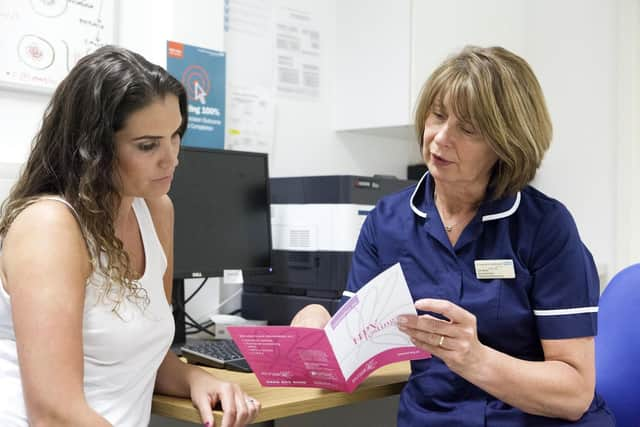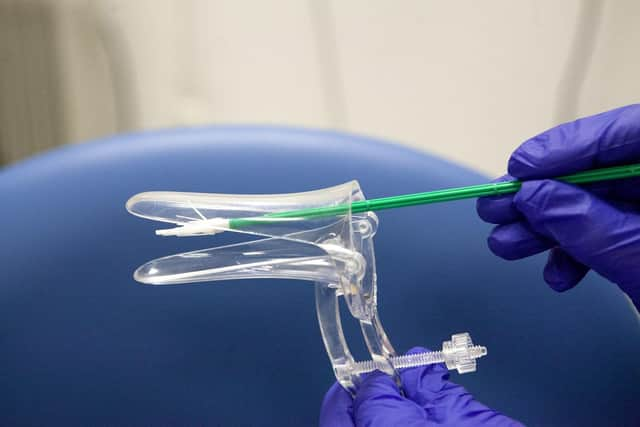Cervical screening awareness: Going for a smear test could mean early cancer detection
and live on Freeview channel 276
It is available to women and people with a cervix aged 25 to 64 in England.
But almost one in three across the UK don’t take up their cervical screening also known as a smear test invitation, according to statistics from charity Jo’s Cervical Cancer Trust.
Advertisement
Hide AdAdvertisement
Hide AdClaire Webb, 48 from Newhaven, was diagnosed with cell changes from a routine smear test aged 40.
She said: “I had a colposcopy and LLETZ procedure where my consultant told me I had severe changes, quite likely cancerous. Up until this point I had not even thought about cancer. A smear was just something I did regularly. In April 2014 my consultant confirmed that I had cervical cancer.”
Claire received a radical hysterectomy with bilateral oophorectomy. Histology showed there had been another tumour at the very top of her cervix.
She was also diagnosed as 1B1 as the cancer had not spread outside of the cervix which meant she did not need to have chemotherapy afterwards.
Advertisement
Hide AdAdvertisement
Hide AdShe said: “I am the biggest advocate for cervical screening. I honestly believe that my smear test saved my life as I had no symptoms. I dread to think what would have happened if I had not had a smear test when I did. Please do not put it off.


“Having a smear test is not something we do for fun, but it is really nothing to be nervous about. It is not painful and the nurse doing it does not care what you look like ‘down there’ .
“You’ll be in and out before you know it.”
The test takes less than five minutes, during which a smooth, tube-shaped tool (a speculum) is inserted, the nurse will open the speculum so they can see the cervix. Using a soft brush, they'll take a small sample of cells from the cervix, which is sent for testing.
Claire has been cancer free for eight years.


She said: “I feel extremely lucky that I was able to have a smear test and catch my cancer early. I never miss an opportunity to encourage people to keep up to date with their smear tests. For my first year cancer free I did a skydive and for my fifth myself and my sisters and friends abseiled the Spinnaker tower to raise awareness for Jo’s.”
Advertisement
Hide AdAdvertisement
Hide AdIt's not a test for cancer, but it is a test to help prevent cancer. Over 99 per cent of cervical cancer cases are preventable as many people can be diagnosed with cell changes before it becomes cancer.
Following a cervical screening in May 2020 Beth Stretton, 27 from West Sussex, received a letter that stated she was HPV positive and have severe high-grade cell changes.
She said: “It was a stressful period, I was extremely anxious as I didn’t understand what that meant at the time! I didn’t even know what the possible outcomes were from a routine screening.
“I had to book into the hospital for a colposcopy where they could take a closer look and treat if necessary, in my case it was.”
Advertisement
Hide AdAdvertisement
Hide AdBeth was treated within a few weeks with large loop excision of the transformation zone (LLETZ) during a colposcopy for CIN 2. LLETZ involves removing the abnormal cells using a thin wire loop that's heated with an electric current.
She said: “Sometimes it can be more stressful to keep putting it off than it can be just to get it over and done with every few years. It isn’t as scary as you think, a little bit uncomfortable but not painful. The main thing; is no matter what the results, there is help.
“Spotting changes early on can be life-changing. The earlier things are treated the better. I found Jo’s Trust to be a great help and source of information that helped me to understand what things were.”
Jo's Cervical Cancer Trust was set up in 1999 by James Maxwell in memory of his wife, Jo who died from cervical cancer at the age of 40. Following her diagnosis in 1995, Jo and James had difficulty finding good information about every aspect of cervical cancer.
Advertisement
Hide AdAdvertisement
Hide AdSamantha Dixon, chief executive of Jo’s Cervical Cancer Trust, said: “We want everyone to have the support and facts they need to access cervical screening and deal with an unexpected result. Cervical screening can help stop cervical cancer before it starts so it’s an incredibly important test.”
The screening looks for the human papillomavirus (HPV) which can cause abnormal cells on the cervix. If HPV is found a cytology test is used as a triage, to check for any abnormal cells.
If no abnormal cells are found, a follow up screen is arranged for 12 months’ time. This will check to see if the immune system has cleared the virus.
Most HPV infections only last a short time, and slightly abnormal cells often go away on their own when the virus clears. If HPV persists, abnormal cells can, if left untreated, turn into cancer over time.
Advertisement
Hide AdAdvertisement
Hide AdThe common symptoms of cervical cancer include: unusual vaginal bleeding, pain or discomfort during sex, vaginal discharge and pain in the area between the hip bones (pelvis). There are many other conditions that cause these symptoms.
A smear test can detect cells even if no symptoms are present.
Cervical Screening Awareness Week runs from June 20 until 26, 2022 and aims to raise awareness of the importance of attending your smear test.